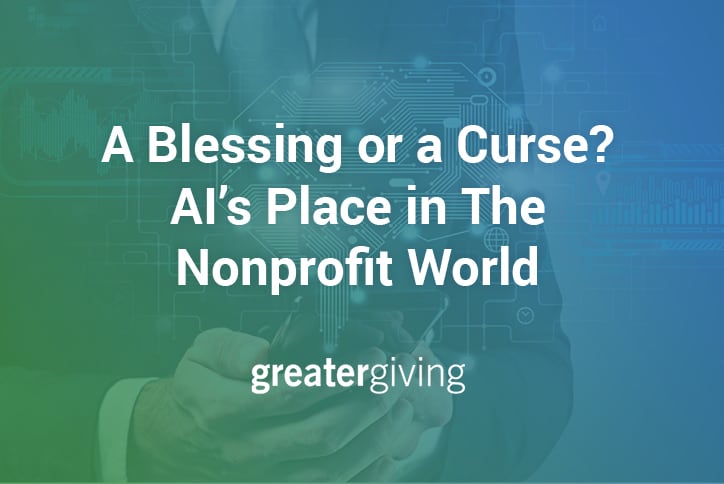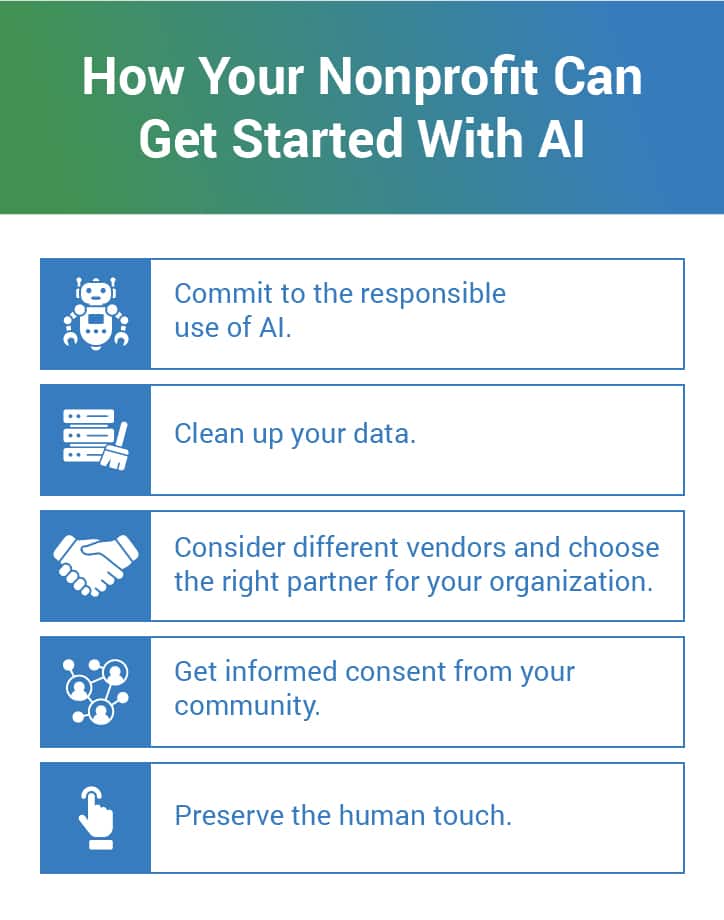
Artificial intelligence (AI) has been a part of our lives for a long time, powering our smartphones’ virtual assistants, personalizing content recommendations on streaming services, and ushering in innovations in self-driving car technology. However, with the rise of ChatGPT in early 2023, there has been more buzz surrounding AI than ever before, especially in the nonprofit sector.
And there are a variety of opinions out there about AI. Many have celebrated the recent advancements in the AI field as major steps forward in improving processes, increasing efficiency, and reducing costs and human error. Others have voiced worries about AI threatening human jobs and perpetuating discrimination. Some have even wondered if AI is going to take over the world, science fiction-style.
Amidst all of this confusing discourse, nonprofits are looking for ways to keep up with new technological trends, maintain trust with their communities, and fundraise more effectively. These organizations are left wondering, “Is AI a blessing or a curse? And should we be using it or not?”
Here’s where we stand: AI, when used responsibly, is a valuable tool that can be used in nonprofit fundraising and beyond. However, it’s up to your organization to understand the benefits and challenges of this technology and to approach the implementation process with care.
Let’s dive into what your nonprofit needs to know to use AI responsibly and successfully.
How AI Works
First, you should have an understanding of what AI is and how it works.
According to DonorSearch’s full guide to AI for nonprofits, AI is a machine’s ability to “think” like a human and perform tasks such as processing information, recognizing patterns, and making recommendations.
Here’s how AI works: AI develops its ability to “think” over time through machine learning, which involves processing data through a mathematical model called an algorithm. The best part about this is that AI can get smarter over time as it processes more and more data.
Your nonprofit will likely encounter two types of AI tools:
- Generative AI tools, which help to create content like text or images. ChatGPT is a great example of a generative AI tool—all you have to do is type in a prompt, and, because the tool’s algorithm has been trained on a wealth of data from across the internet, it can quickly respond to the prompt. Another example is Adobe Photoshop’s new Generative Fill tool, which allows you to input a prompt and add to an image or even extend it.
- Predictive AI tools, which intake data, analyze it for patterns and trends, and then produce specific predictions and recommendations. For example, a fundraising tool like DonorSearch Ai can take a massive amount of donor data, supplemented by external datasets, and make specific predictions about individual donors. Or, your Netflix account can collect data about what you like to watch and then cater its content suggestions to your preferences.
Both generative and predictive AI can be useful for nonprofits. For instance, maybe you’re experiencing writer’s block while creating your Giving Tuesday email stream. You could turn to ChatGPT to help you outline captivating, story-centered messages that get people excited about contributing to your campaign.
On the other hand, predictive AI tools can especially help organizations interested in taking a deep dive into who their donors are and how to effectively engage them. As you get started with AI, remember to consider your organization’s needs so you can determine which tools to leverage!
Benefits and Risks of Using AI
While there are some extreme views out there about AI, in reality, these innovations come with both benefits and risks. Let’s take a closer look at some that your nonprofit needs to be aware of:
The Benefits of AI
Society may still be gaining its footing with new AI technologies, but they aren’t going anywhere. AI can help your nonprofit:
- Get accurate and actionable supporter insights. With the right AI tools, you can go deeper with prospect and donor research. Instead of just knowing your donors’ names, contact information, and the date of their last donation, you can learn about their engagement histories and communication preferences. Plus, you can predict things like who is likely to donate in the next year or who is likely to donate a certain amount.
- Use its resources more efficiently. Your organization is probably used to doing a lot with very little. AI can help you make the most of your team’s time, energy, and money by fully automating some tasks and assisting with others.
- Personalize its communications. More and more, nonprofit supporters need to feel personally connected to the organizations they care about to stay engaged. AI can provide you with insights about your community so you can develop a marketing and communication strategy tailored to your supporters.
- Detect fraud. AI can learn what looks like a normal donation or transaction for your nonprofit and then help to flag fraudulent activity so that you can quickly take care of it.
The Risks of AI
There are also some risks that come with using AI, though you should note that you can avoid many of these risks by putting the right guardrails in place. Let’s take a closer look at these potential obstacles:
- Ethical issues. Because your nonprofit will likely need to leverage its donor data to get the most out of its AI tools, this may raise some concerns about the security of your supporters’ sensitive data. Additionally, if not created or curated with care, the algorithms and data used in an AI tool can sometimes perpetuate biases, even if it’s unintentional.
- Dependence on technology. Even though AI is adept at a lot of things, it can never fully replace humans, especially when it comes to connecting with others and demonstrating empathy. AI can quickly put your nonprofit at risk of coming across as disingenuous and uncaring if you’re not monitoring its outputs or editing its deliverables.
- Unintended consequences. While many risks can be avoided, it’s important to know that, even when used with the best intentions, AI can sometimes have unintended consequences. For instance, an AI chatbot created by the National Eating Disorders Association had to be taken down after giving harmful advice.
At the end of the day, the benefits that your nonprofit can experience from using AI greatly outweigh the risks of tapping into this new technology. But to protect yourself from risk and set yourself up to get the most out of your AI tools, you’ll need a solid plan.
How Nonprofits Can Get Started With AI
Getting started with AI involves so much more than just shopping for the right tool. Before you start comparing vendors, you need to position your organization for success and go into the AI implementation process with the goal of maintaining trust and transparency with your community.
Here are some steps to follow to help you get started:

- Commit to the responsible use of AI. Using AI responsibly means ensuring that everything you do with AI at your nonprofit promotes privacy, security, ethics, inclusiveness, and accountability. You can learn more by exploring the Responsible AI Framework created by the Fundraising.AI collaborative.
- Clean up your data. If you’re interested in using a predictive AI tool that will require you to provide it with data about your nonprofit’s supporters, take the time to clean up and organize that data. For instance, delete duplicate entries, correct inaccurate information, and standardize the way you input information like dates.
- Consider different vendors and choose the right partner for your organization. When you’re ready, you can start shopping for an AI tool, keeping your goals and budget in mind. Check out different software review sites to get an idea of how each vendor approaches AI or ask for recommendations from trusted colleagues. It’s also a good idea to request a demo of each tool so you can see it in action before making your final pick, and to prepare questions for each vendor that will help you gauge if their approach and tools align with your values and commitment to using AI responsibly.
- Get informed consent from your community. Let your community know that you’re going to be using their information in an AI tool to improve how your nonprofit operates and make your work more effective. Be sure to give existing supporters a chance to decline to have their data used, and also get in the habit of securing consent from newly-acquired supporters. This will demonstrate that your nonprofit values its relationships and is using AI the right way.
- Preserve the human touch. Once you’ve fully integrated your new tool into your operations, remember that you still need humans involved in your processes. For instance, if you’re using AI to take notes for you in meetings with major donors, it’s a good idea to review those notes right after the meeting and add anything you might have missed. You’ll still be saving time by using the AI tool, but by reviewing the notes it takes, you’ll ensure that you have all the information needed for effective major donor stewardship.
Additionally, consider gathering feedback on how your nonprofit is using AI from your staff members and trusted supporters. Then, act on their suggestions to improve your processes so that AI can continue to be an asset for you rather than something that puts your organization at risk!
So, is AI a blessing or a curse?
We say that AI is a blessing—it has the potential to revolutionize how nonprofits fundraise and connect with their communities.
But there’s a catch.
AI will only be an effective tool for your nonprofit if you understand what it is, how it works, the benefits and risks it presents, and how you can implement it in the right way. Use this guide to get on the right path to successful AI adoption, and remember to use your new tools responsibly!
